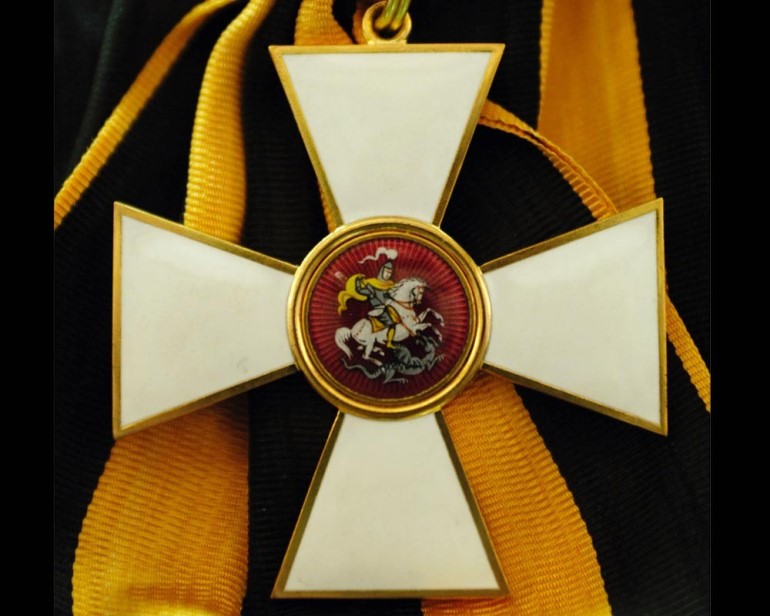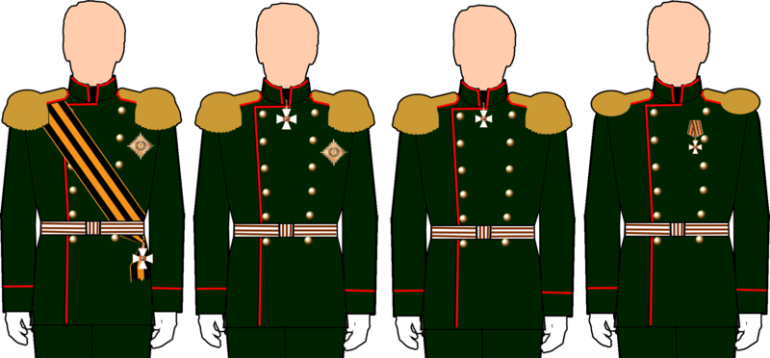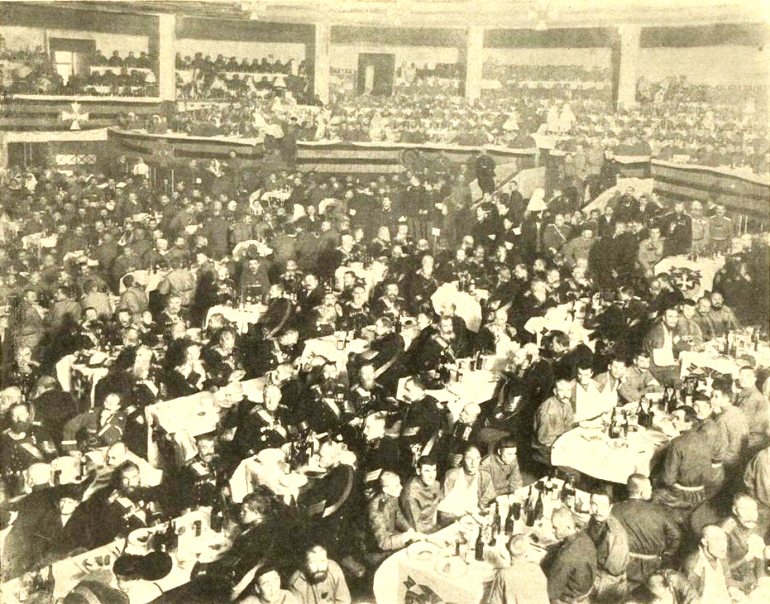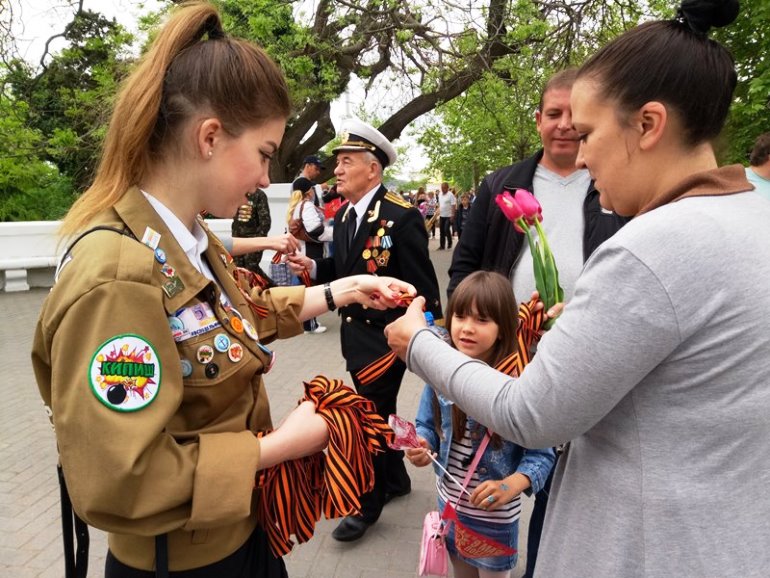
Order of Saint George celebrates its 250th anniversary
/ Главная / Russkiy Mir Foundation / Publications / Order of Saint George celebrates its 250th anniversaryOrder of Saint George celebrates its 250th anniversary
Sergey Vinogradov
In December 1769, the decree on the establishment of the Order of St. George as the highest military decoration of the Russian Empire was signed by Empress Catherine the Great. It was pointed out that the order should not be awarded for the “noble race”, but for “special acts of courage,” that is, for personal valor. In modern times, the Order of St. George, abrogated in 1917, was revived; the statute of the order was signed by Russian President Vladimir Putin in 2000.
20 years ago no one really could suspect that a few years later the St. George Ribbon would become the most important patriotic symbol of new Russia. Today, the St. George Ribbon is distributed on the streets and in Russian culture centers in dozens of countries. Residents of many of them perceive the St. George Ribbon not only as the symbol of Victory in the Great Patriotic War, but also as an international symbol of fight against Nazism. The St. George Ribbon also became the symbol of Donbass Resistance; it was worn by Russian-speaking protesters in the Baltic states and other countries.

The Order of Saint George. Photo credit: stavropolskiy.com
For personal valor
Establishment anniversary of the Order of St. George is celebrated by nearly all leading museums in Russia (see below for more details) related to the history of Russia. What makes the Order unique is that it has not become an archival relic with its great history, but exists to this day; it is awarded to soldiers and officers who distinguished themselves on battlefields. The Order has not lost its significance for the Russian émigré community; and even in Soviet times, when the award did not formally exist, the colors of St. George were transferred to the Order of Glory established in 1943.
All this allows us to say that the Order of St. George is the most famous award in the history of Russia. Yevgeny Yurkevich, one of the foremost experts in military history of Russia, said that during his webinar, which was held on the website of the Boris Yeltsin Presidential Library.
– In addition to the four awarding classes for officers and a whole range of awards for the lower ranks - the St. George Cross and medals, the Order of St. George also had the most significant complements, such as St. George banners, standards, colors, pipes and horns, and even St. George forces and units. None of the military orders of the world had such elements,” the historian emphasizes the uniqueness of the award.

Proper wear of the Order of Saint George (from left to right: for the first to the fourth classes). Photo credit: ru.wikipedia.org
– I am delighted that the Order was revived in Russia, as well as the St. George holiday on December 9, albeit it is celebrated under the changed name - Heroes of the Fatherland Day,” the scientist shared. - This is the date that h to be remembered and must be celebrated, because recipients of the Order of St. George have done a lot for Russia, and not only in the military field - their contribution to Russian science and culture is priceless
According to Yurkevich, the Order was known and revered in hostile armies. They tried to capture recipients of the Order of St. George, including soldiers, considering them high-ranking military personnel. Often, dead soldiers were identified by number of the St. George Cross.

Colonel Mikhail Kutuzov with the first award, the Order of St. George, 4th class. Photo credit: ru.wikipedia.org
– Analyzing exploits by recipients of the Order of St. George, we find that almost each of such exploits is something special, astonishing even for wartime, the historian says. - I recall the exploit by Agafon Nikitin, an artilleryman and recipient of the Order of St. George. In 1880, during the siege of the Geok-Tepe fortress, he was taken prisoner. Enemies, seeing the award, did not kill him. Instead they requested to teach them how to fire captured Russian cannon. Nikitin refused and was brutally executed.
The revival of the Order and arrangement of the St. George Ribbon campaign are the extremely important events in the history of the country. “The Order of St. George and the St. George Ribbon have become one of the most striking symbols of Russia, creating, protecting and contending country,” the award historian believes. “Moreover, it is not only for Russians, but also for all those who appreciate Russia, Russian culture, and Russian civilization.”
Orders under the glass
You can see the authentic St. George crosses that belonged to famous Russians and even emperors, learn history of the award and biographies of its recipients in the leading Russian museums. Thousands of exhibits related to the Order are on display. One day is not enough for residents and guests of Moscow and St. Petersburg to visit all the exhibitions dedicated to the Order of St. George. Fortunately, there are a lot of interesting facts, copies of documents and images posted in the Internet.
There is For Service and Valor Exhibition in the Moscow Historical Museum. The exposition includes European military orders, which became the prototypes for the highest military decoration of Russia, as well as earlier Russian awards dating back to the reign of Anna Ioannovna and Catherine the Great. Visitors can see evolution of orders by comparing awards from different ages, including modern ones. Among the exhibits, the Order of St. George of General Vladimir Shamanov, the Hero of Russia, who was among the first recipients of the revived award.
The Hermitage hosts the exhibition “For Service and Bravery. 250 Years of the Military Order of St George”. Authors of the exposition have presented more than four hundred exhibits related to the Order and its recipients. In particular, there are the Orders of St. George that belonged to Emperors Catherine the Great and Alexander II, as well as a coat of the latter with the St. George Ribbon. The exhibition has received special significance due to the Great Throne Hall, where it is located. It was the very venue where major celebrations associated with the Order of St. George were held before the revolution.

Lunch of recipients of the Order of St. George in the folk house of Nicholas II, 1915. Photo credit: ru.wikipedia.org
The exhibition was opened in the Military Historical Museum of Artillery, Engineers and Signal Corps. Here you can see memorial uniforms, personalized St. George crosses (with stories of awarding) and other awards that belonged to Emperors Alexander I and Nicholas I, grand dukes, outstanding soldiers and commanders.
Interesting collection of historical materials related to the Order and its history is presented on the website of the Presidential Library, which collects electronic copies of documents related to history of Russia. Here you can see the decree by Catherine the Great on establishment of the award and learn stories of its most famous recipients.
More than just a ribbon
The St. George ribbon, which became a kind of followup of the Order of St. George (both in appearance and in essence), turned into a symbol and campaign under the same name in 2005, ahead of celebration of the 60th anniversary of the Victory. It was originated within student and volunteer community of Moscow and St. Petersburg. Then the campaign outspread rapidly, and after a few years it became international.
And the number of countries where ribbons are distributed on the streets and in the Russian culture centers grows year by year. In 2018, the campaign was officially held in nearly 80 countries around the world on almost all continents. St. George Ribbons were fixed on clothes and bags, tied around the wrist and attached to car mirrors in the USA, Great Britain, Canada, Germany, Spain, France, Israel, the Baltic and many other countries. Hundreds of thousands of tapes are distributed annually abroad.

St. George Ribbon Campaign, Sevastopol. Photo credit: molgvardia.ru
Number of countries and cities involved in the campaign increases, as well as number of people who come to the campaign organizers for the Ribbon, because they know what it means. According to Darko Nestorov, one of the organizers of the St. George Ribbon campaign in Northern Macedonia, you can meet people with St. George ribbons in Skopje all year round, and there are cars painted in the colors of the Russian order driving along the city streets.
Darko Nestorov is a professor at the Ss. Cyril and Methodius University of Skopje, where the Russian Center operates. “We hold the St. George Ribbon campaign each year, either independently or jointly with other organizations,” he told the Russkiy Mir. “The campaign takes place in the Russian Center and the University, and if the weather is fine, we go to the square in the city center.”
According to the professor, annually they distribute more than three thousand St. George Ribbons in Skopje. Many residents of the Macedonian capital have already got used to the campaign and come to distribution points to pick the ribbon. “There are no issues in finding volunteers. The young people who are involved in activities of the Russian Center are happy to participate in the campaign,” said the professor. “They know the meaning of the ribbon very well and are able to clearly explain it to people passing by. Many of them now are aware what this symbol means. ”
The campaign sparks great interest in Skopje, because Northern Macedonia does not have its own memorial symbols for victims of the World War II, but there is such a demand in society. “The St. George Ribbon is increasingly perceived as an international symbol of fight against fascism,” Darko Nestorov believes.
New publications

 Mikhail Kalatozov, a director who transformed the world of cinematography in many ways, was born 120 years ago. He was a Soviet film official and a propagandist. Above all, he was capable of producing movies that struck viewers with their power and poetic language.
Mikhail Kalatozov, a director who transformed the world of cinematography in many ways, was born 120 years ago. He was a Soviet film official and a propagandist. Above all, he was capable of producing movies that struck viewers with their power and poetic language.  Ukrainian authorities have launched a persecution campaign against the canonical Ukrainian Orthodox Church (UOC), the biggest one in the country's modern history. Over the past year, state sanctions were imposed on clergy representatives, searches were conducted in churches, clergymen were arrested, criminal cases were initiated, the activity of the UOC was banned in various regions of the country, and monasteries and churches were seized.
Ukrainian authorities have launched a persecution campaign against the canonical Ukrainian Orthodox Church (UOC), the biggest one in the country's modern history. Over the past year, state sanctions were imposed on clergy representatives, searches were conducted in churches, clergymen were arrested, criminal cases were initiated, the activity of the UOC was banned in various regions of the country, and monasteries and churches were seized.  When Nektary Kotlyaroff, a fourth-generation Russian Australian and founder of the Russian Orthodox Choir in Sydney, first visited Russia, the first person he spoke to was a cab driver at the airport. Having heard that Nektariy's ancestors left Russia more than 100 years ago, the driver was astonished, "How come you haven't forgotten the Russian language?" Nektary Kotlyaroff repeated his answer in an interview with the Russkiy Mir. His affinity to the Orthodox Church (many of his ancestors and relatives were priests) and the traditions of a large Russian family brought from Russia helped him to preserve the Russian language.
When Nektary Kotlyaroff, a fourth-generation Russian Australian and founder of the Russian Orthodox Choir in Sydney, first visited Russia, the first person he spoke to was a cab driver at the airport. Having heard that Nektariy's ancestors left Russia more than 100 years ago, the driver was astonished, "How come you haven't forgotten the Russian language?" Nektary Kotlyaroff repeated his answer in an interview with the Russkiy Mir. His affinity to the Orthodox Church (many of his ancestors and relatives were priests) and the traditions of a large Russian family brought from Russia helped him to preserve the Russian language.

 The leaders of the Friends of the Great Russia cultural association (Amici Della Grande Russia) in Italy believe that the Western policy of abolishing Russian culture in Europe has finally failed. Furthermore, it was doomed to failure from the beginning.
The leaders of the Friends of the Great Russia cultural association (Amici Della Grande Russia) in Italy believe that the Western policy of abolishing Russian culture in Europe has finally failed. Furthermore, it was doomed to failure from the beginning.  Name of Vladimir Nemirovich-Danchenko is inscribed in the history of Russian theater along with Konstantin Stanislavski, the other founding father of the Moscow Art Theater. Nevertheless, Mr. Nemirovich-Danchenko was a renowned writer, playwright, and theater teacher even before their famous meeting in the Slavic Bazaar restaurant. Furthermore, it was Mr. Nemirovich-Danchenko who came up with the idea of establishing a new "people's" theater believing that the theater could become a "department of public education."
Name of Vladimir Nemirovich-Danchenko is inscribed in the history of Russian theater along with Konstantin Stanislavski, the other founding father of the Moscow Art Theater. Nevertheless, Mr. Nemirovich-Danchenko was a renowned writer, playwright, and theater teacher even before their famous meeting in the Slavic Bazaar restaurant. Furthermore, it was Mr. Nemirovich-Danchenko who came up with the idea of establishing a new "people's" theater believing that the theater could become a "department of public education."  "Russia is a thing of which the intellect cannot conceive..." by Fyodor Tyutchev are famous among Russians at least. December marks the 220th anniversary of the poet's birth. Yet, he never considered poetry to be his life's mission and was preoccupied with matters of a global scale. Mr.Tyutchev fought his war focusing on relations between Russia and the West, the origins of mutual misunderstanding, and the origins of Russophobia. When you read his works today, it feels as though he saw things coming in a crystal ball...
"Russia is a thing of which the intellect cannot conceive..." by Fyodor Tyutchev are famous among Russians at least. December marks the 220th anniversary of the poet's birth. Yet, he never considered poetry to be his life's mission and was preoccupied with matters of a global scale. Mr.Tyutchev fought his war focusing on relations between Russia and the West, the origins of mutual misunderstanding, and the origins of Russophobia. When you read his works today, it feels as though he saw things coming in a crystal ball...